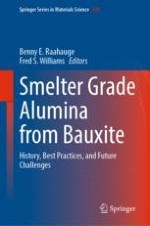2022 | OriginalPaper | Buchkapitel
10. Production of Smelter Grade Alumina (SGA) by Calcination
verfasst von : Benny E. Raahauge
Erschienen in: Smelter Grade Alumina from Bauxite
Aktivieren Sie unsere intelligente Suche, um passende Fachinhalte oder Patente zu finden.
Wählen Sie Textabschnitte aus um mit Künstlicher Intelligenz passenden Patente zu finden. powered by
Markieren Sie Textabschnitte, um KI-gestützt weitere passende Inhalte zu finden. powered by
